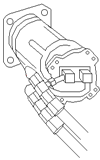Ag Power Web Enhanced Course Materials
Air Conditioning
- Introduction
- Lecture Notes
- Part Identification
- Animated Examples
- Job Sheets
(coming soon) - Terms/Definitions
Reference Links
Helpful Links
If you experience any problems with the site, please contact Pete Hoffman immediately so corrections can be made. Pete can be reached on campus, via email at phoffman@swtc.edu or by phone at 1.800.362.3322 ext 2727.
Compressor
 |
The purpose of the compressor is to circulate the refrigerant in the system under pressure, this concentrates the heat it contains.
|
- This pressure buildup can only be accomplished by having a restriction in the high pressure side of the system. This is a small valve located in the expansion valve.
The compressor has reed valves to control the entrance and exit of refrigerant gas during the pumping operation. These must be firmly seated.
- An improperly seated intake reed valve can result in gas leaking back into the low side during the compression stroke, raising the low side pressure and impairing the cooling effect.
- A badly seated discharge reed valve can allow condensing or head pressure to drop as it leaks past the valve, lowering the efficiency of the compressor.
Two service valves are located near the compressor as an aid in servicing the system.
- One services the high side, it is quickly identified by the smaller discharge hose routed to the condenser.
- One is used for the low side, the low side comes from the evaporator, and is larger than the discharge hose
The compressor is normally belt-driven from the engine crankshaft. Most manufacturers use a magnetic-type clutch which provides a means of stopping the pumping of the compressor when refrigeration is not desired.
Compressor Relief Valve
Some compressors have a relief valve for regulating pressure. If the system discharge pressure exceeds rated pressure, the valve will open automatically and stay open until the pressure drops. The valve will then close automatically.
Compressor Noise Complaints
Many noise complaints can be traced to the compressor mount and drive.
- If a unit is noisy at one speed and quiet at another, it is not compressor noise.
- Many times this kind of noise can be eliminated or greatly reduced by changing the belt adjustment.
- Usually tightening mounts, adding idlers, or changing belt adjustment and length are more successful in removing or reducing this type of noise, than replacing the compressor.
- Noises from the clutch are difficult to recognize because the clutch is so close to the compressor. A loose bolt holding the clutch to the shaft will make a lot of noise.
- The difference, between suction pressure and discharge pressure, also plays an important part on sound level.
- A compressor with low suction pressure will be more noisy than one with a higher pressure.
- Consider whether the system is properly charged, whether the expansion valve is feeding properly to use the evaporator efficiently, and whether enough air is being fed over the evaporator coil.
Part Identification - Compressor